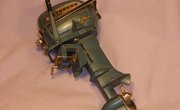Drive and Power
An inboard engine works just like a car engine in terms of how it creates power and delivers drive to the boat. It is, in the case of a gas or petrol inboard, a combustible engine that has cylinders which fill with fuel and air. A spark ignites this fuel air mixture to create an explosion. This combustion (another term for explosion), pushes a piston downwards. This piston is connected to a drive shaft or crank shaft, so when it goes down it turns the shaft part way. A series of pistons being pushed down at intervals cause the drive shaft to spin. This is where the spinning motion is born.
Gears and Auxilary
An inboard can't push or move anything without something to push against the water. In the case of most inboards, the pushing is done by propellers mounted under the boat's hull, most often right off the stern. When the engine provides power, it is distributed down a shaft via a gear box or transmission. This shaft eventually connects to the propellers and causes them to spin. The faster the drive shaft turns (caused by a faster series of explosions in the engine) the faster the propellers move and, in turn, the faster you get to your favorite fishing hole.
Cooling
The only point at which an inboard differs from a car engine (aside from the fact that it is connected to propellers) is in the cooling system. An inboard is cooled by water, like a car, but it does not use a common radiator, like a car engine. That is because the inboard is surrounded by water and it is more efficient to use this water for cooling, than to include a radiator. Water is actually pumped up into the inboard from outside. The exact way in which this happens varies by machine; some use a hose, others have a hole in the stern through which water enters. All will use the water to cool the engine, then push it back out of the system along with the exhaust from the engine. That's why you see water coming out of the back of an inboard boat.
Writer Bio
Steve Smith has published articles on a wide range of topics including cars, travel, lifestyle, business, golf, weddings and careers. His articles, features and news stories have appeared in newspapers, consumer magazines and on various websites. Smith holds a Bachelor of Arts in English and journalism from University of New Hampshire Durham.



